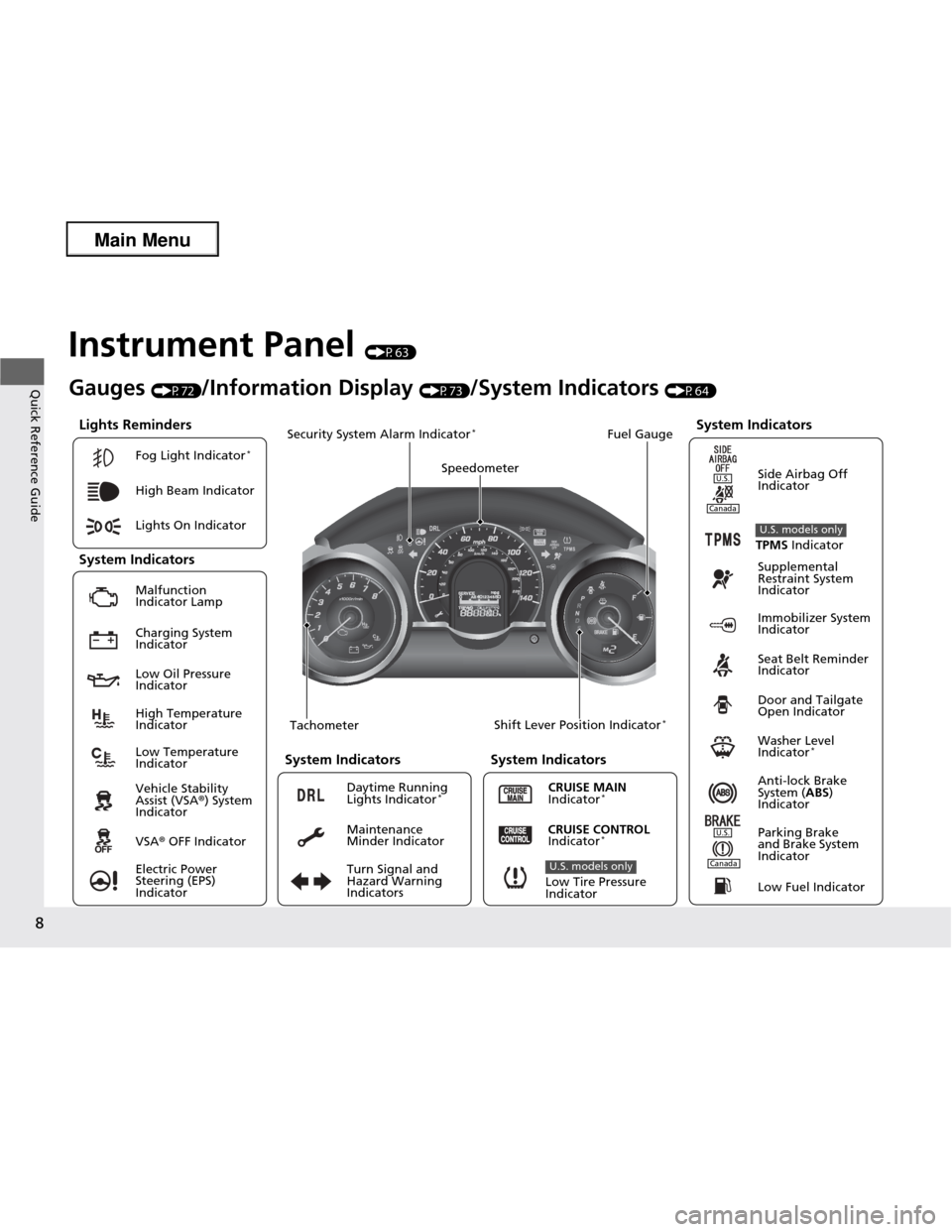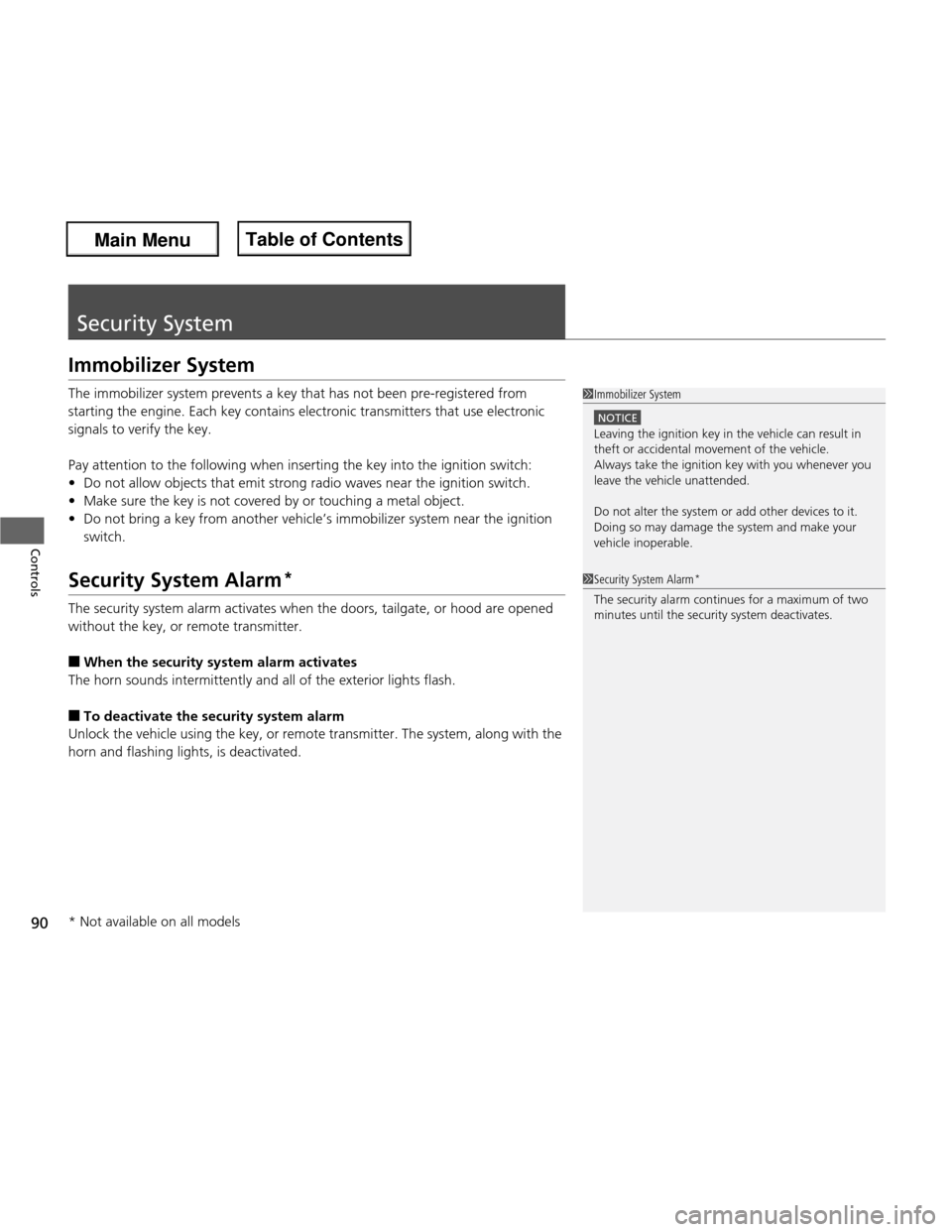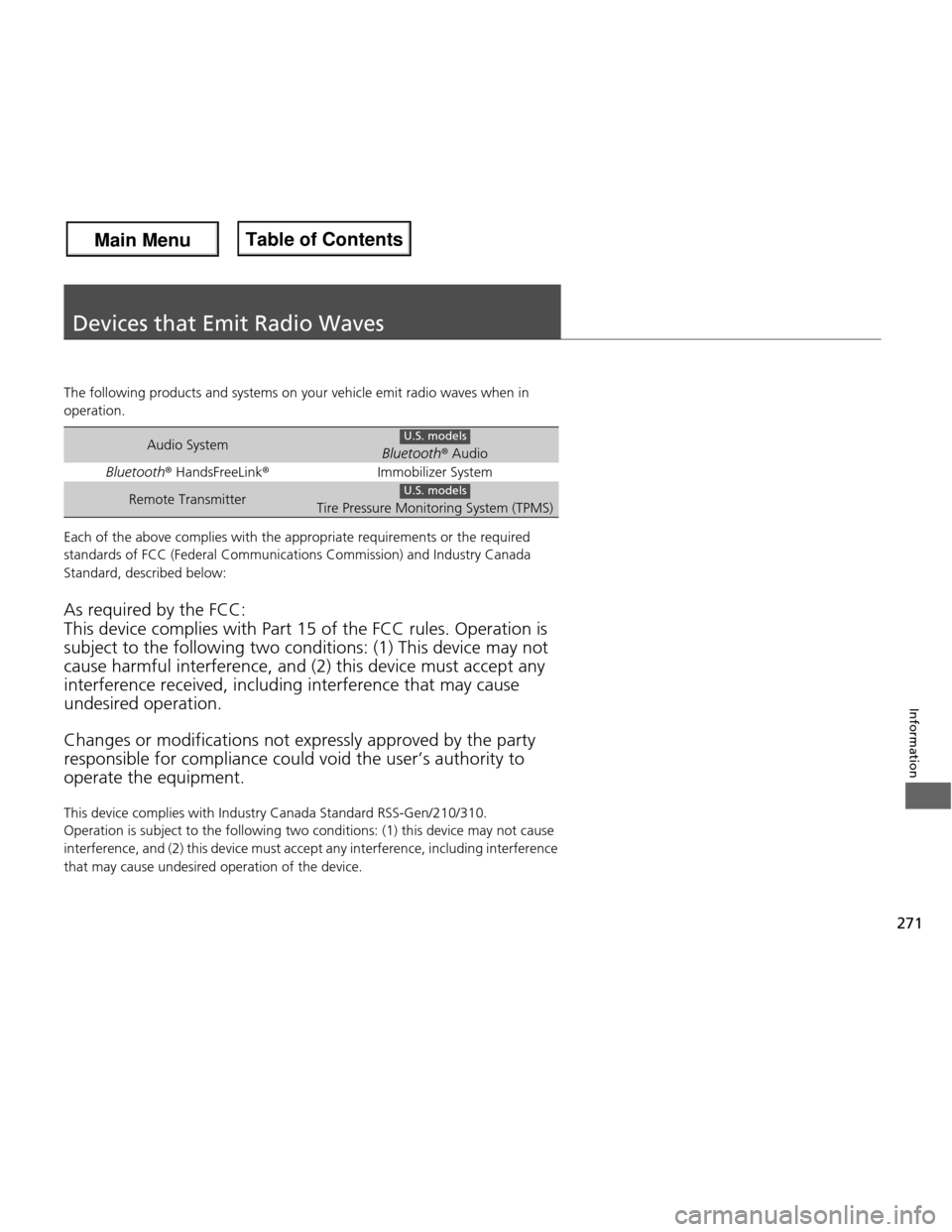2013 HONDA FIT immobilizer
[x] Cancel search: immobilizerPage 9 of 286

8
Quick Reference Guide
Instrument Panel (P63)
Lights Reminders
Malfunction
Indicator Lamp Low Oil Pressure Indicator Anti-lock Brake
System (ABS)
Indicator
Vehicle Stability Assist (VSA
®) System
Indicator VSA ® OFF Indicator
Electric Power Steering (EPS) Indicator
Lights On Indicator
High Beam Indicator
Immobilizer System
Indicator
Seat Belt Reminder
Indicator
System Indicators
CRUISE MAIN
Indicator * Supplemental
Restraint System
Indicator
Side Airbag Off
Indicator
Door and Tailgate
Open Indicator
Tachometer Speedometer
Fuel Gauge
Security System Alarm Indicator *
Shift Lever Position Indicator *
Low Fuel Indicator
Gauges
(P72)/Information Display (P73)/System Indicators (P64)
Turn Signal and Hazard Warning Indicators
High Temperature Indicator
Low Temperature Indicator
System Indicators System Indicators
Low Tire Pressure
Indicator
U.S. models only
Parking Brake
and Brake System
IndicatorCRUISE CONTROL
Indicator * System Indicators
Charging System Indicator
U.S.
U.S.
Canada
TPMS
Indicator
U.S. models only
Washer Level
Indicator *
Daytime Running Lights Indicator
*
Maintenance
Minder Indicator
Fog Light Indicator
*
Canada
Main Menu
Page 71 of 286

70
uuIndicatorsu
Instrument Panel
IndicatorNameOn/BlinkingExplanation
Turn Signal Indicators
●The turn signal indicators blink when you
operate the turn signal lever.
● If you press the hazard warning button,
both indicators and all turn signals blink
at the same time.●Does not blink or blinks rapidly - A turn signal
light bulb has blown. Change the bulb immediately. 2Replacing Light Bulbs P. 213, 216
High Beam Indicator
●
Comes on when the high beam
headlights are on.
● Comes on with reduced brightness when DRL (daytime running lights) are on.
—
Lights On Indicator
●Comes on whenever the light switch is
on when the exterior lights are on.●If you remove the key from the ignition switch while
the lights are on, a chime sounds when the driver’s door is opened.
Fog Light Indicator *
●
Comes on when the fog lights are on.
—
Immobilizer System
Indicator
●Comes on briefly when you turn the
ignition switch to ON
(w , then goes off.
● Comes on if the immobilizer system
cannot recognize the key information.
●Blinks - You cannot start the engine. Turn the
ignition switch to LOCK
(0 , pull the key out, and
then insert the key and turn it to ON
(w again.
● Repeatedly blinks - The system may be
malfunctioning. Have the vehicle checked by a dealer.
● Do not attempt to alter this system or add other
devices to it. Electrical problems can occur.
* Not available on all models
Main Menu
Main MenuTable of Contents
Page 76 of 286

75
Controls
This chapter explains how to operate the various controls necessary for driving.
Setting the Clock................................ 76
Locking and Unlocking the Doors
Key Types and Functions .................... 77
Locking/Unlocking the Doors from the Outside ............................................ 79
Locking/Unlocking the Doors from the Inside ............................................... 82
Childproof Door Locks ....................... 83
Auto Door Locking/Unlocking *
.......... 84
Opening and Closing the Tailgate Using the Key *
................................... 88
Using the Tailgate Open Handle ......... 89
Security System .................................. 90
Immobilizer System ............................ 90 Security System Alarm
*
...................... 90
Opening and Closing the Windows .. 92
Operating the Switches Around the
Steering Wheel Ignition Switch ................................... 94
Turn Signals ....................................... 95
Light Switches.................................... 95 Fog Lights *
........................................ 96
Daytime Running Lights ..................... 96
Wipers and Washers .......................... 97
Brightness Control ............................. 99
Rear Defogger/Heated Door Mirror *
Button ........................................... 100
Adjusting the Steering Wheel........... 101 Adjusting the Mirrors
....................... 102
Interior Rearview Mirror ................... 102
Power Door Mirrors ......................... 102
Adjusting the Seats .......................... 103
Adjusting the Seat Positions ............. 103
Interior Lights/Interior Convenience Items ................................................ 111
Interior Lights .................................. 111
Interior Convenience Items .............. 113
Heating and Cooling *
....................... 118
Using Vents, Heating and A/C *
........ 118
* Not available on all models
Main Menu
Main Menu
Page 78 of 286

77
Continued
Controls
Locking and Unlocking the Doors
Key Types and Functions
This vehicle comes with the following keys:
Use the keys to start and stop the engine, and
to lock and unlock all the doors, and tailgate.
You can also use the remote transmitter *
to
lock and unlock the doors, and tailgate.
■Keys
1Key Types and Functions
All of the keys have an immobilizer system. The
immobilizer system helps to protect against vehicle
theft. 2 Immobilizer System P. 90
The keys contain precision electronics.
Adhere to the following advice to prevent damage to
the electronics:
• Do not leave the keys in direct sunlight, or in
locations with high temperature or high humidity.
• Do not drop the keys or set heavy objects on them.
• Keep the keys away from liquids.
• Do not take the keys apa rt except for replacing the
battery.
If the circuits in the keys are damaged, the engine
may not start, and the re mote transmitter may not
work.
If the keys do not work properly, have them
inspected by a dealer.
Ignition Keys *
Ignition Keys with Remote Transmitter
*
* Not available on all models
Main Menu
Main MenuTable of Contents
Page 91 of 286

90
Controls
Security System
Immobilizer System
The immobilizer system prevents a key that has not been pre-registered from
starting the engine. Each key contains electronic transmitters that use electronic
signals to verify the key.
Pay attention to the following when inserting the key into the ignition switch: •Do not allow objects that emit strong radio waves near the ignition switch.
• Make sure the key is not covered by or touching a metal object.
• Do not bring a key from another ve hicle’s immobilizer system near the ignition
switch.
Security System Alarm *
The security system alarm activates when the doors, tailgate, or hood are opened
without the key, or remote transmitter. ■ When the security system alarm activates
The horn sounds intermittently and all of the exterior lights flash. ■ To deactivate the security system alarm
Unlock the vehicle using the key, or remote transmitter. The system, along with the
horn and flashing lights, is deactivated.
1Immobilizer System
NOTICE
Leaving the ignition key in the vehicle can result in
theft or accidental movement of the vehicle.
Always take the ignition key with you whenever you
leave the vehicle unattended.
Do not alter the system or add other devices to it.
Doing so may damage the system and make your
vehicle inoperable.
1Security System Alarm *
The security alarm continues for a maximum of two
minutes until the security system deactivates.
* Not available on all models
Main Menu
Main MenuTable of Contents
Page 163 of 286

uuWhen DrivinguStarting the Engine
162
Driving
3. Turn the ignition switch to START (e
without depressing the accelerator pedal.
1. Keeping your right foot on the brake pedal, release the parking brake. Check that
the brake system indicator has gone off.
2 Parking Brake P. 181
2. Put the shift lever in
(D . Select (R when reversing.
3. Gradually release the brake pedal and gently depress the accelerator pedal to pull away.
1Starting the Engine
Do not hold the key in START
(e for more than 15
seconds.
• If the engine does not start right away, wait for at least 10 seconds before trying again.
• If the engine starts, but then immediately stops,
wait at least 10 seconds before repeating step 3
while gently depressing the acce lerator pedal.
Release the accelerator pedal once the engine
starts.
The immobilizer system protects your vehicle from
theft. If an improperly coded device is used, the
engine’s fuel system is disabled. 2 Immobilizer System P. 90
■Starting to Drive
Automatic transmission models
Main Menu
Main MenuTable of Contents
Page 251 of 286

250
Handling the Unexpected
Engine Does Not Start
Checking the Engine
If the engine does not start, turn the ignition switch to START
(e and check the
starter.
Starter conditionChecklist
Starter doesn’t turn or turns over slowly.
The battery may be dead. Check
each of the items on the right and
respond accordingly.Check brightness of the interior light.
Turn on interior lights and check brightness. ● If the interior lights are dim or do not come on at all
2Battery P. 231
● If the interior lights come on normally 2 Inspecting and Changing Fuses P. 263
The starter turns over normally
but the engine doesn’t start.
There may be a problem with the
fuse. Check each of the items on
the right and respond accordingly.Review the engine start procedure.
Follow its instructions, and try to start the engine again. 2 Starting the Engine P. 161
Check the immobilizer system indicator.
When the immobilizer system indicator is blinking, the engine cannot be started.
2Immobilizer System P. 90
Check the fuel level. There should be enough fuel in the tank. 2 Fuel Gauge P. 72
Check the fuse.
Check all fuses, or have the vehicle checked by a dealer.
2Inspecting and Changing Fuses P. 263
If the problem continues:
2 Emergency Towing P. 264
1Checking the Engine
If you must start the vehicle immediately, use an assisting vehicle to jump start it.
2 Jump Starting P. 251
Main Menu
Main MenuTable of Contents
Page 272 of 286

271
Information
Devices that Emit Radio Waves
The following products and systems on your vehicle emit radio waves when in
operation.
Each of the above complies with the appropriate requirements or the required
standards of FCC (Federal Communications Commission) and Industry Canada
Standard, described below: As required by the FCC: This device complies with Part 15 of the FCC rules. Operation is subject to the following two conditions: (1) This device may not
cause harmful interference, and (2) this device must accept any interference received, i ncluding interference that may cause
undesired operation. Changes or mo difications not expressly approved by the party
responsible for compliance could void the user’s authority to operate the equipment.
This device complies with Ind ustry Canada Standard RSS-Gen/210/310.
Operation is subject to the following two conditions: (1) this device may not cause
interference, and (2) this device must accept any interference, including interference
that may cause undesired operation of the device.
Audio SystemBluetooth ® Audio
Bluetooth ® HandsFreeLink ®Immobilizer System
Remote TransmitterTire Pressure Monitoring System (TPMS)
U.S. models
U.S. models
Main Menu
Main MenuTable of Contents